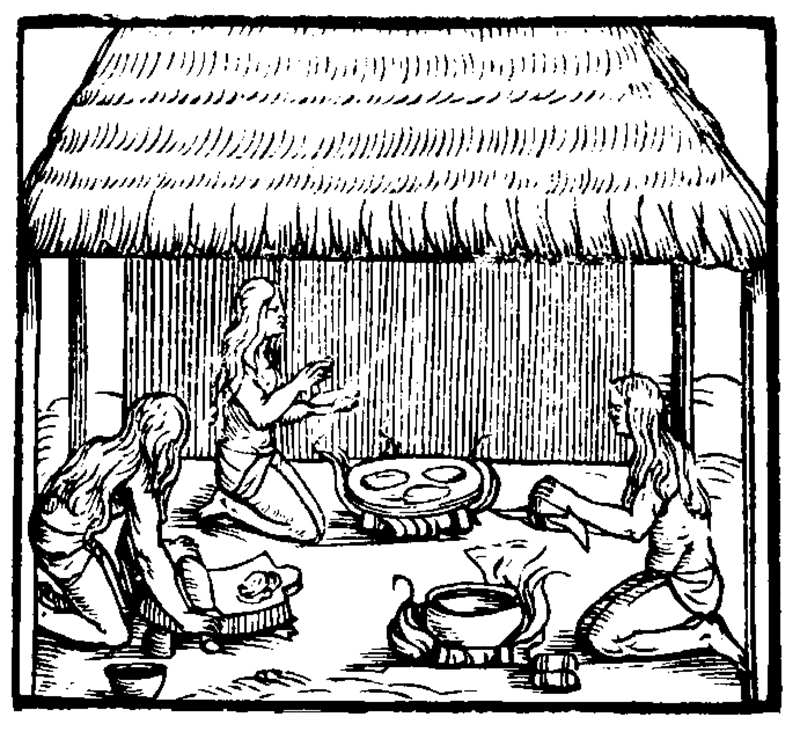At the time of Columbus’s first contact, the Taíno were the most numerous indigenous people of the Caribbean and inhabited what are now Cuba, Jamaica, Haiti, the Dominican Republic, Puerto Rico, and the Virgin Islands.
Food and Diet
Their agriculture included a wide variety of crops – cassava, maize, peanuts, tomato, squash, and beans plus many fruits including pineapple, guava, soursop, custard apple, and papaya. Their primary crop was cassava, which had to be processed to remove dangerous levels of cyanide. To do this, the cassava was grated and placed into a woven container that was twisted to remove the toxic juice. It was then baked into a bread-like slab. They grew tobacco which they enjoyed socially but also in religious ceremonies. They extracted black and red dyes from native trees (Genipa americana and Bixa orellana) to stain their bodies. For textiles, they grew cotton.
The Taino diet on the coasts centered around meat or fish as the primary source of protein. There were no large wild animals but there were lots of rodents, snakes, birds, worms, and insects that the Taino consumed. In the lakes and seas could be found ducks, turtles, and fish. Taíno fishing technologies were most inventive, including harpoons, cotton fishnets, and traps.
Culture and Land Use
The Taíno culture was a well-organized, flourishing communal society. Most lived peacefully in towns and villages grouped into numerous principalities called cacicazgos with an almost feudal social structure. The islands were divided among caciquats or kingdoms, each governed by a cacique (chief). The cacique’s function was to maintain the welfare of the village by assigning daily work and making sure everyone got an equal share. Below him were lesser caciques presiding over villages in subdivisions called nitaínos. The cacicazgos each incorporated between seventy and a hundred communities, some of which had many hundreds of residents.
Ecogeography and Agricultural Practices
The Caribbean of the Taino has a warm, humid tropical climate characterized by diurnal temperature variations that are greater than the annual variations; temperatures are modified by elevation. Rain is common throughout the year.
The Taino raised their crops on large mounds called conuco (Sturtevant 1961). These mounds were 3-feet tall with a contour of 9–12 feet, separated by 2–3 feet from each other. They were packed with leaves and litter to facilitate drainage. Depending on population, the surface area covered by farms could be quite large. In Puerto Rico, farms of 50,000–80,000 mounds were reported (Lamarche 2019).
Before Columbus, the primary antagonists of the Taino were the Caribs of the lesser Antilles. The Caribs were a warrior people with much less developed agriculture than the Taino. They utilized the slash-and-burn system. The men did the chopping and burning to clear openings in forests, while the women tended the crops and the men went on war excursions. They cultivated cassava, sweet potato, chili peppers, maize, gourds, and pineapple. They consumed wild fruits including guava, papaya, and carob. Caribs fed mostly on crabs, turtles, and their eggs, conchs, fish, and birds. They enjoyed a sauce made with chili peppers and manioc juice.
Near extinction
The Taíno became almost extinct following the settlement of the Caribbean by colonists, due to infectious diseases brought by the Spanish, overwork as slaves, and starvation. The first recorded smallpox outbreak in Hispaniola occurred in December 1518 or January 1519 and killed 90% of the natives who had not already perished. By 1548, the native population had declined to fewer than 500 from a high point of one to two million at Columbus’s arrival.
Illustration: Taíno women preparing cassava bread. La Historia del Mondo Nuovo 1565, Girolamo Benzoni
Bibliography:
Hancock, J. F. (2022) World agriculture before and after 1492. The Legacy of the Columbian Exchange. Springer
Lamarche SR (2019) Tainos and Caribs: the aboriginal cultures of the Antilles. Editorial Punto y Coma, San Juan, Puerto Rico
Sturtevant WC (1961) Taino agriculture. In: Wilbert J (ed) The evolution of horticultural systems in native South America, causes and consequences: a symposium. Sociedad de Ciencias Naturales La Salle, Caracas, pp 69–82
